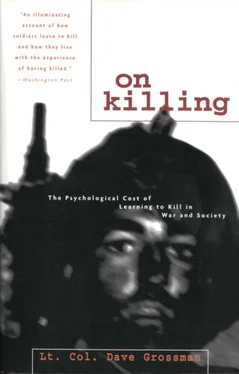Instead of firing at a bull’s-eye target, the modern soldier fires at man-shaped silhouettes that pop up for brief periods of time inside a designated firing lane. The soldiers learn that they have only a brief second to engage the target, and if they do it properly their behavior is immediately reinforced when the target falls down. If he knocks down enough targets, the soldier gets a marksmanship badge and usually a three-day pass. After training on rifle ranges in this manner, an automatic, conditioned response called automatically sets in, and the soldier then becomes conditioned to respond to the appropriate stimulus in the desired manner. This process may seem simple, basic, and obvious, but there is evidence to indicate that it is one of the key ingredients in a methodology that has raised the firing rate from 15 to 20 percent in World War II to 90 to 95 percent in Vietnam.
Conditioning at the Video Arcade
In video arcades children stand slack jawed but intent behind machine guns and shoot at electronic targets that pop up on the video screen. When they pull the trigger the weapon rattles in their hand, shots ring out, and if they hit the “enemy” they are firing at, it drops to the ground, often with chunks of flesh flying in the air.
The important distinction between the killing-enabling process that occurs in video arcades and that of the military is that the military’s is focused on the enemy soldier, with particular emphasis on ensuring that the U.S. soldier acts only under authority. Yet even with these safeguards, the danger of future My Lai massacres among soldiers drawn from such a violent population must not be ignored, and, as we saw in the section “Killing and Atrocity,” the U.S. armed forces are taking extensive measures to control, constrain, and channel the violence of their troops in future conflicts. The video games that our children conduct their combat training on have no real sanction for firing at the wrong target.
This is not an attack on all video games. Video games are an interactive medium. They demand and develop trial-and-error and systematic problem-solving skills, and they teach planning, mapping, and deferment of gratification. Watch children as they play video games and interact with other children in their neighborhood. To parents raised on a steady diet of movies and sitcoms, watching a child play Mario Brothers for hours on end may not be particularly gratifying, but that is just the point. As they play they solve problems and overcome instructions that are intentionally inadequate and vague. They exchange playing strategies, memorize routes, and make maps. They work long and hard to attain the gratification of finally winning a game. And there are no commercials: no enticements for sugar, no solicitation of violent toys, and no messages of social failure if they do not wear the right shoes or clothes.
We might prefer to see children reading or getting exercise and interacting with the real world by playing outside, but video games are definitely preferable to most television. But video games can also be superb at teaching violence — violence packaged in the same format that has more than quadrupled the firing rate of modern soldiers.
When I speak of violence enabling I am not talking about video games in which the player defeats creatures by bopping them on the head. Nor am I talking about games where you maneuver swordsmen and archers to defeat monsters. On the borderline in violence enabling are games where you use a joystick to maneuver a gunsight around the screen to kill gangsters who pop up and fire at you. The kind of games that are very definitely enabling violence are the ones in which you actually hold a weapon in your hand and fire it at human-shaped targets on the screen. These kinds of games can be played on home video, but you usually see them in video arcades.
There is a direct relationship between realism and degree of violence enabling, and the most realistic of these are games in which great bloody chunks fly off as you fire at the enemy.
Another, very different type of game has a western motif, in which you stand before a huge video screen and fire a pistol at actual film footage of “outlaws” as they appear on the screen. This is identical to the shoot-no shoot training program designed by the FBI and used by police agencies around the nation to train and enable police officers in firing their weapons.
The shoot-no shoot program was introduced nearly twenty years ago in response to the escalating violence in our society that was resulting in an increase in deaths among police officers who hesitated to shoot in an actual combat situation. And, of course, we recognize it as another form of operant conditioning that has been successful in saving the lives of both law-enforcement officers and innocent bystanders, since the officer faces severe sanctions if he fires in an inappropriate circumstance. Thus the shoot-no shoot program has served successfully to both enable and constrain violence among police officers. Its video arcade equivalent has no such sanctions to constrain violence. It only enables.
The worst is yet to come. Just as movies have become successively more realistic in their depiction of violence and death, so too have video games. We are now entering an era of virtual reality, in which you wear a helmet that has a video screen before your eyes. As you turn your head the screen changes just as though you were within the video world. You hold a gun in your hand and fire it at the enemies who pop up around you, or you hold a sword and hack and stab at the enemies around you.
Alvin Toffler, author of Future Shock, says, “This manipulation of reality may provide us with exciting games, entertainment, but it will substitute not a virtual reality, but a pseudo reality, so subtly deceptive as to raise the levels of public suspicion and disbelief beyond what any society can tolerate.” This new “pseudo reality” will make it possible to replicate all the gore and violence of popular violent movies, except now you are the one who is the star, the killer, the slayer of thousands.
Through operant conditioning B. F. Skinner held that he could turn any child into anything he wanted to. In Vietnam the U.S. armed forces demonstrated that Skinner was at least partially correct by successfully using operant conditioning to turn adolescents into the most effective fighting force the world has ever seen. And America seems intent on using Skinner’s methodology to turn us into an extraordinarily violent society.
CHAPTER FOUR
Social Learning and Role Models in the Media
The basic training camp was designed to undermine all the past concepts and beliefs of the new recruit, to undermine his civilian values, to change his self-concept — subjugating him entirely to the military system.
— Ben Shalit
The Psychology of Conflict and Combat
Classical (Pavlovian) conditioning can be done with earthworms, and operant (Skinnerian) conditioning can be conducted on rats and pigeons. But there is a third level of learning that pretty much only primates and humans are capable of, and that is what is called social learning.
This third level of learning, in its most powerful form, revolves primarily around the observation and imitation of a role model. Unlike operant conditioning, in social learning it is not essential that the learner be directly reinforced in order for learning to take place. What is important in social learning is to understand the characteristics that can lead to the selection of a specific individual as a role model.
The processes that make someone a desirable role model include:
• Vicarious reinforcement. You see the role model being reinforced in a manner that you can experience vicariously.
Читать дальше







